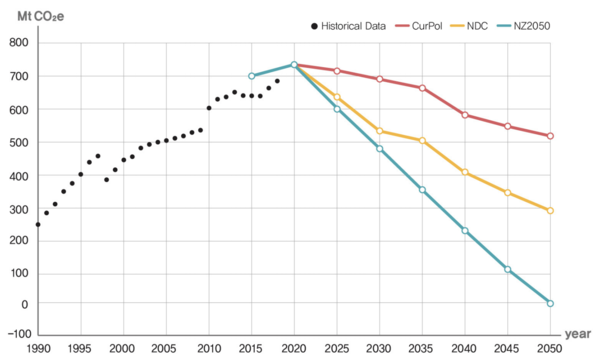An assessment study conducted by researchers from the Graduate School of Green Growth revealed that South Korea’s current policies on climate change are highly inadequate to reach the country’s short- and long-term emissions targets. The team, led by Professor Jiyong Eom, collaborated with the University of Maryland and nonprofit organization Solutions for Our Climate to develop GCAM-KAIST 1.0 — an integrated assessment model (IAM) that represents the behavior of and interactions between various sectors of the economy. The model helped the researchers to analyze three scenarios of Korea’s transition to carbon neutrality.

In 2020, South Korea submitted its climate action plan to the United Nations Framework Convention on Climate Change (UNFCCC) secretariat. In the plan, the country has pledged to reduce its total greenhouse gas (GHG) emissions by 24.4% below 2017 levels by 2030 and to achieve carbon neutrality, or net-zero carbon dioxide emissions, by 2050.
For Korea to achieve these goals, a close analysis of its current policies and an establishment of additional efforts needed are imperative. Although activists and experts proposed sectoral GHG reduction policies before, there was no consistent scenario assessment study that connects all economic activities and consequential emissions in Korea. This became the primary objective of Professor Eom and his team’s research. The team adapted the Global Change Analysis Model (GCAM) — a system used by major climate policy evaluation studies, including IPCC reports — to the Korean context. By linking macroeconomics to energy systems, land use, and climate systems, the model helped researchers analyze three GHG reduction pathways that Korea could take, given its current goals and policies. The first scenario reflects the outcome that can be brought by the current energy and climate policies in force or confirmed to go into effect. The second scenario, on the other hand, assumes that Korea will reach its 2030 target through additional GHG reduction efforts in each sector of the economy and continues making the same level of effort thereafter. In the third scenario, the 2050 carbon neutrality is achieved by curtailing Korea’s annual GHG emissions linearly from 2025.
The team’s report revealed that the current climate policies enacted by the Korean government are highly insufficient to realize both the 2030 and 2050 plans. According to the model, the share of renewable energy in the energy sector must increase sevenfold by 2030 and twentyfold by 2050 to make it possible. Moreover, the coal power generation must be cut down to 10% of total power generated by 2030. Given that coal is the primary source of power in Korea, this task can prove to be challenging for the government. Overall, they suggest that electrification will play a vital role in reducing GHG reductions, including the decarbonization of the power sector and the use of electric cars. In terms of additional policies, the report suggests setting a more ambitious 2030 GHG reduction target, since it is inconsistent with IPCC’s goal of keeping global warming under 1.5° C. Additionally, it is vital for Korea to exit power coal generation and secure a Climate Response Fund to support enhanced efficiency of energy technology.

